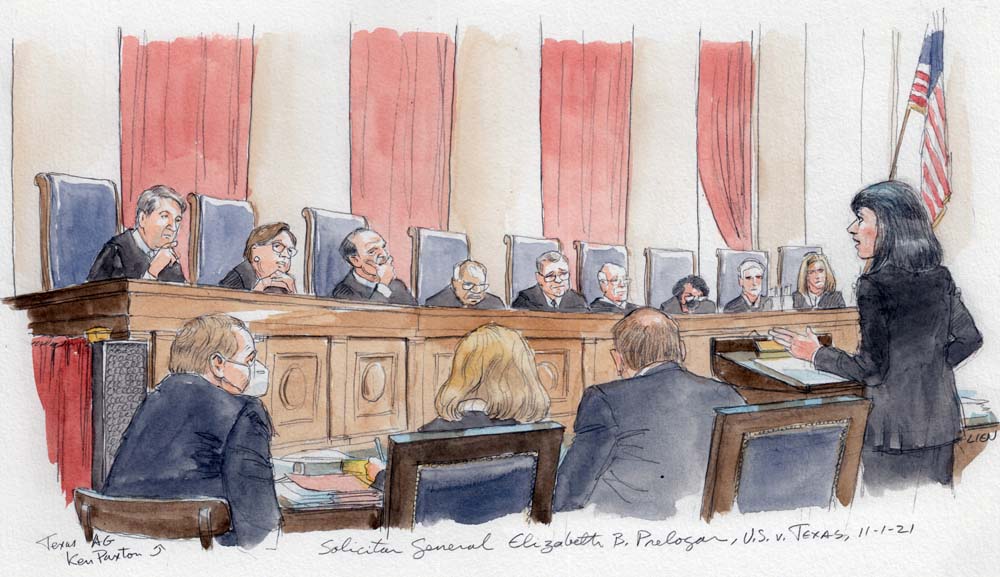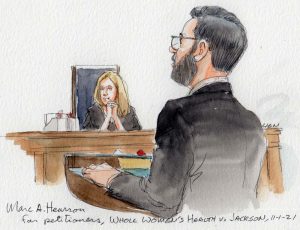A VIEW FROM THE COURTROOM
Two cases. Three hours of arguments. Four sets of lawyers. Fifty mentions of abortion. One pair of red socks.

on Nov 1, 2021 at 7:30 pm

A View from the Courtroom is an inside look at significant oral arguments and opinion announcements unfolding in real time.
An anchorman for one of the morning news shows on Monday hyped the upcoming arguments in Whole Woman’s Health v. Jackson and United States v. Texas by saying the Supreme Court would weigh “the constitutionality of the Texas abortion law.”
Not so fast. As one justice would say a little later, “we’re obviously not dealing with” the merits of the state’s restrictive law today. That would be true over nearly three hours of arguments focusing on whether the state had improperly shielded the law known as S.B. 8 from federal court review.
But still, the underlying issue is abortion rights, and there will be some reminders today of the stakes.
One question upon entering the courtroom is whether all the lawyers participating in the two distinct arguments will be present for what is scheduled to be two total hours for the two cases. Under the court’s COVID-19 protocols, counsel for the second case remain in the lawyers’ lounge, where they can listen to the arguments in the first case before moving to the courtroom. But today’s cases are sufficiently intertwined, and one lawyer is arguing in both, so the decision has been made that the four sets of lawyers will be present the whole time.

Texas Solicitor General Judd Stone. (Art Lien)
At around 9:40 a.m., Judd Stone, the Texas solicitor general, is joined by one colleague in the second chair of the lead table. Soon enough, they are joined by a third chair, Texas Attorney General Ken Paxton, a Republican who has been under indictment on state securities-fraud charges for more than six years. He has denied the charges, and is evidently still a member in good standing of the Supreme Court Bar, so he has pulled up a chair at the end of his team’s table.
At the other lead table is Marc Hearron, who will argue for Whole Woman’s Health, and a colleague. At the second table on the Texas side is Jonathan Mitchell, the former clerk to Justice Antonin Scalia who is said to have been the architect of the Texas abortion law. He also has a colleague in the second chair of the secondary table.

Marc Hearron argues for Whole Woman’s Health. (Art Lien)
Arriving at the second table on the other side is newly confirmed U.S. Solicitor General Elizabeth Prelogar, Deputy Solicitor General Brian Mitchell (who served as acting SG while Prelogar’s nomination was pending), and another colleague.
The SG’s team walks a few steps to greet their “friends” on both sides, which is when I notice that Prelogar is not wearing the traditional morning coat donned by the solicitor general. This is in keeping with the precedent set by one of Prelogar’s mentors, Justice Elena Kagan, who declined to wear the morning attire when she became solicitor general in 2009.
It is only with trepidation that I discuss attire in the courtroom at all, so at this point I’ll note that Paxton is making a fashion statement, too. He is wearing bright red dress socks, which can’t possibly escape notice by the justices because of his seat at the edge of the table. The “Guide for Counsel in Cases to Be Argued,” distributed by the clerk’s office and which presumably applies to second and third chairs as well as arguing lawyers, recommends “conservative business dress in traditional dark colors (e.g., navy blue or charcoal gray).” But it doesn’t specify anything about socks.
As with the October sitting, the general public remains left out of the courtroom, with credentialed Supreme Court reporters and justices’ law clerks spaced apart in the public gallery. In the VIP section, Joanna Breyer arrives and is soon joined by Jane Roberts. Breyer will stay the entire time, while Roberts will leave after about an hour.
When the justices take the bench at 10 a.m., Chief Justice John Roberts has a few preliminary matters. He begins by noting that today is the 30th anniversary of the investiture of Justice Clarence Thomas. As I have , there is a subtle change in the script between a member of the court’s 25th anniversary on the job, when the chief justice refers to “many more years of our common calling,” and the 30-year mark, when all bets are off and some more general congratulations are offered.
Roberts, on behalf of the court, says “I would like to extend to Justice Thomas our heartfelt congratulations on what is, for all of us, a very happy anniversary.” Thomas gives a short nod of thanks.
Roberts next recognizes Fletcher, thanking him for his service as acting solicitor general. Fletcher, in turn, introduces Prelogar as the new solicitor general.
The chief justice welcomes Prelogar to her “important duties” and notes that she is the 48th solicitor general of the United States, and “the 10th solicitor general of Justice Thomas’ tenure.” This prompts a hearty laugh from Thomas.
Prelogar thanks the chief justice, and notes that it will be “an honor to serve.” Her first important duty will be to argue a pretty major case, just days after her confirmation.
Roberts then calls the Whole Woman’s Health case, and the three-hour marathon of arguments begins. Amy Howe has SCOTUSblog’s main account. After a fair amount of attention in recent weeks to the study of interruptions on the court, which Justice Sonia Sotomayor said publicly was a factor in some of the tinkering with oral argument procedure, the justices seem especially courteous today.
“I don’t want to interrupt your answer to Justice Sotomayor,” Justice Samuel Alito says early on in the first argument, “but just to pick up on a point that you made, and maybe you could clarify this before you finish answering her question, if you haven’t finished already.”
Justice Brett Kavanaugh interrupts Hearron, then says, “Sorry to interrupt,” and only continues his question when the lawyer defers.
But later, Alito breaks into an answer from Prelogar with, “Let me just interrupt you …”
It is Kavanaugh who frames a question to Prelogar by reminding everyone that “we’re obviously not dealing with” the merits of the Texas abortion law today.
During one of the seriatim rounds of questioning (which we have learned were meant at least in part to address interruptions), Kagan asks Hearron “if I could turn technical for minute.” If many listeners thought all of today’s arguments were relatively technical to begin with, her question about the relief being sought is indeed a bit complicated.
Still, the arguments in both cases often come back to abortion. It is mentioned more than 30 times in the first case today, and more than 20 times in the second. It will surely be mentioned many times when the court takes up the constitutionality of the Mississippi abortion law in Dobbs v. Jackson Women’s Health Organization on Dec. 1. And network news morning anchors won’t be overstating the nuances when that case comes along.


